 Facebook
Facebook
 X
X
 Instagram
Instagram
 TikTok
TikTok
 Youtube
Youtube
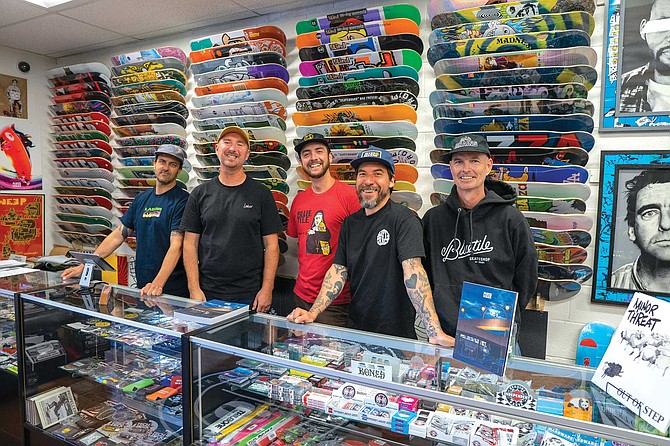
June 10th began gray and damp, the way it had been all spring. But by the afternoon, the concrete at the Rancho Peñasquitos skatepark was dry, the DJ was spinning, and you could hear the man on the mic urging the local skaters to land their tricks and “get some of this Red Bull money!” Sponsor happy talk like that might have tempted you to think that this was some corporate-backed festival, but the vibe in the park was more organic, more like a block party. The skaters who had come out would have come out on any other day, they just would have been more chill. As it was, they were taking rapid-fire runs at the same rail or gap, those who bailed had barely enough time to grab their boards before another body came barreling along. Each time one of them landed a trick, the crowd cheered, and the triumphant skater rolled past a guy who was waiting with bills in hand, snagged a twenty, and got back in the lineup to try something new.
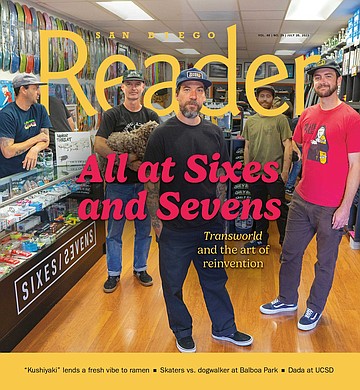
While standing with the spectators I met Mike Fitzgerald, who grew up skating in Peñasquitos (or PQ) and now lives here with his wife and their two children. “There’s been more things happening at this skatepark in six months than there has been in 18 years,” he told me. “And that’s all because of the shop and Paul.” The shop is Sixes and Sevens, sitting one block away, and the Paul is Paul Kobriger, its founder. It’s equal parts skateshop, art gallery, record store, music venue — anything it needs to be, really. Fitzgerald (or “Fitz”) may be biased in his opinion of the place, as he’s one of the five friends who Kobriger brought in as partners. But he’s right on the facts: more events have happened here, and there really is something new going on, some energy being brought into an otherwise ordinary piece of suburbia. It’s amazing: that skaters young and old are coming to PQ to see their pro heroes, that those pros are coming here at all, that there’s a crowd of people hanging out outside an 800 square foot shop in a strip mall. All this points to something special going on inside.
It starts to make sense when you learn that Kobriger and most all his partners came from Transworld SKATEboarding magazine, or TWS, one of the biggest media titles in the skate industry. Despite that status, it shuttered its print publication in 2019, and left nearly all of Kobriger and his partners adrift, searching for something else into which they could pour their skate-loving hearts.
The Day It Went Down
One evening in late January of 2019, an impromptu staff meeting was called for the start of the next day — never a good sign. Transworld had about a dozen full-time employees, and that morning, they arrived expecting the worst. For Brian Blakely, the managing editor who’d just spent two months recovering from an ATV accident that took his right arm, it was his first day back in the office. After arriving, employees were split into two groups: one in the conference room, one in the mag’s skatepark. If you were in the park, you were getting let go, laid off, the ol’ pink slip — sometimes it seems there are as many euphemisms for losing a job as there are for dying. The axe didn’t fall all at once, but the pandemic was coming, and soon enough, the surviving camp dwindled as well. The downsizing was part of an acquisition, and though this wasn’t the first time the magazine had changed hands, this time was different —in part because it happened during its leanest times. Transworld and a handful of action sports brands under The Enthusiast Network was bought by American Media, Inc., of National Enquirer fame. The elimination of print is almost expected in the digital age, but the salt in the wound was that the remainder of subscriptions would be fulfilled with issues of that atlas of ripped abs, Men’s Journal.
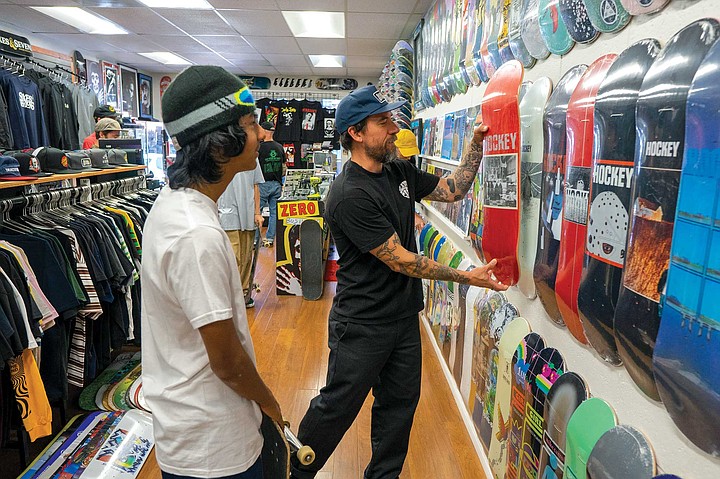
Enough: there’s no need to dwell upon the decline of print media — especially not in the pages of one of the last free local weeklies in town (and if you’re reading this without battery power, bravo, you old soul). As much as it made old-school hearts ache, after 36 years it was time to bid farewell to what many would have called the most professional and most polished skate publication going. Thrasher has always worn its rawness with pride. To sum up, the loss of a printed Transworld SKATEboarding was indeed a loss. But this is not a story of decline; it’s the story of the rise that followed after. Because that’s the thing about print, right? You can’t move on unless you turn a page.
The Art of Reinvention
Paul Kobriger had been Transworld’s marketing director, the guy in charge of special events and promotion. With a family of five to support, he started doing some contract work with industry connections. But out of necessity, he also leaned hard into his art — a hobby he’d been working on for a few years before the TWS exodus. He hadn’t drawn a single line since high school, but over time, he’d been inspired by the side projects and hustles of his TWS colleagues. “They were all creatives in and outside of their day jobs,” he says. “Being around them every day inspired me to have some sort of creative outlet, too.” He took up a simple Bic pen and set to recreating a TWS cover that featured a monotone, high-contrast photo — well-suited for ink.
“I knew I didn’t want to do pencil like everyone else,” he says. “A lot of people don’t realize you can manipulate a ball-point just like a pencil, but you have to get the technique down —light strokes, layer by layer. It started out as a practice piece, but I just kept going with it. You can actually see it getting better from the left side to the right as I progressed through the drawing.” The result was enough to blow some minds when he showed it around the office. Fitz puts it best: “It was like knowing someone ten years and suddenly they sit at a piano and play Mozart. We were all like, ‘What?!’”
Paul moved on to large-scale, hyper-realistic portraits, starting by working (with permission) from photo portraits of his three longtime skate heroes: the perpetually comic Lance Mountain, the ever-cheerful Ray Barbee, and the consummately creative Mark Gonzales. “I discovered that if you’re trying to connect with people, portraits just work well. At least more so than drawing a skyline or street corner, or something like that. And especially with those three skaters — they were my favorite skaters growing up. Anyone that started skating around that era would probably tell you the same thing.”
While most anyone would be staggered by the detail in each, Paul can see his work progressing throughout the series, getting more and more photorealistic. “Lance is done in stipple; I didn’t have confidence in shading yet, because ball-points are finicky. You have to figure out how to manipulate them so a big black ink gob doesn’t suddenly bleed out. Obviously, you can’t erase.”
There’s a coffee mug on his desk that holds empty pens — empty as in bone-dry, with a crystal-clear barrel. An 18”x24” piece takes only one or two pens. Time is another matter. “Each is at least 150 hours, often more. I start with a pencil sketch and then use a grid system to ink it; one square inch takes about an hour with a pen, depending on the detail.” So it’s as much labor as it is love. When the magazine folded and he had mouths to feed, he thought how his Transworld colleagues had told him he could have a future in art. “I always told myself I wouldn’t sell the originals until I could get what I thought they were worth, based on the time that goes into them,” he says. “And yeah, soon after I offered the originals on Instagram, they all sold. Letting them go was a little bittersweet, but I was stoked that I had built a following and could sell them for what I held out for.”
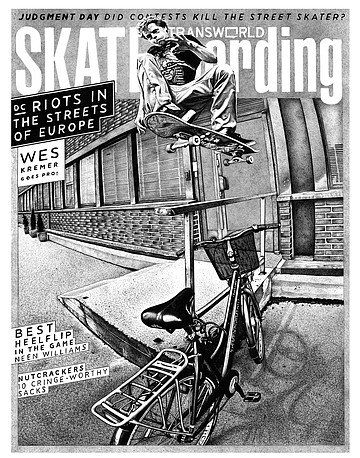
All the while, Kobriger was skating at his go-to park in Peñasquitos. Over time, the thought started creeping up on him: here was a park that drew skaters from all over, near lots of family-friendly neighborhoods producing new skaters every year, and yet there was no dedicated skateshop nearby. Outside of the craziness of starting a business in general, the idea of filling that particular niche wasn’t all that crazy.
Paul had worked in or with skateshops for nearly his whole career, running marketing for Sun Diego Boardshops and CCS.com, the largest online skate retailer of its time. But to get his own shop going, he’d need partners. He knew who to ask — and for all five of them, it was an easy answer. “You can see it in his art,” says Fitz. “Anything he does, Paul goes all-in. He probably could have asked us to be a part of anything he was starting, and we’d have agreed in an instant.”
Fitz was the first ask; he knew PQ and could literally see the shop location from his house; Blair Alley also grew up in PQ and was still holding on at Transworld, running the entire show online, with Brian Blakely on contract for web stories. They were both in, as was Paul’s designer, Matt Kriegel, who would be cut in on whatever merch he designed for the shop. And though he rounds out this roundup of partners, former editor-in-chief Jaime Owens wasn’t the last to be asked and was definitely not the least. He’s just got a whole reinvention story of his own.
Long Live Print
For Owens, the end of the print mag was a rude awakening from a dream career he fell into 24 years prior. Fresh to SoCal from South Carolina, a then-25-year-old Owens sent an email to Skateboarder — the only magazine that printed staff emails — and was, to his surprise, taken right under the wing of photographer Mike Ballard, who needed help hauling equipment. This put him in the right place at the right time to get involved in the first season of a new MTV show, Jackass, before it became the sensational nut-punching media franchise. Connections ensued, and Jaime was offered a full-time gig at Skateboarder, working his way up over the years from essentially a paid intern to editor-in-chief. That mag folded in 2013, but he slid right into the same role at Transworld. “There’s always some degree of paranoia working in publications,” he says. “If you’re not wondering whether you’ll put out another issue next month, you’re wondering if the ad numbers are being hit, and it can be stressful.”
With more than 20 years in skate magazines, Jaime has seen the thick and thin times, which manifest themselves physically when you stack issues and look at the spines. In the early 00’s, Transworld was almost an inch thick and flush with advertisers; toward the end, it was a considerably trimmer issue, even though it was put out every other month. He’d been a part of all kinds of efforts to modernize over the years, like digital issues with still images that came to life as video that were the last gasp of Skateboarder. “The thought was everyone was going to have an iPad and that’s how content would be consumed. That didn’t really pan out, but we pioneered some really cool stuff.” Social media is what really turned the tide, which makes sense when you consider skateboarding’s history as captured by grassroots, guerilla-style coverage — it became what it is today only because skaters captured each other on film. Photographers like J. Grant Brittain, Glen E. Friedman and C. R. Stecyk III documented the early days like ethnographers, and skate mags were the culture’s National Geographic. When camcorders became widespread in the ‘90s, magazines started producing their own videos, which became requisite for any company in skateboarding, media or otherwise. But once everyone could reach everyone else instantly and globally via the device in their pocket, skaters became their own media outlets. That diluted the role of the magazine as the source for the latest and greatest, and accelerated the pace of content production well beyond what a perfect-bound monthly could match.
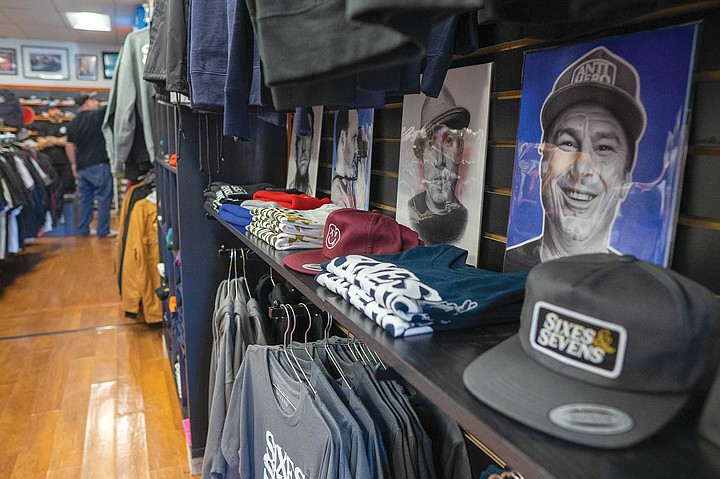
Though Owens was relieved to be without deadlines for the first time in two decades, TWS’s print death still left a void. He kept skateboarding every day, took freelance photo gigs and worked on one-off projects, but he couldn’t shake the longing for some way to share his true enthusiasm. “All I knew was making skate magazines and skate content. And that’s all I wanted to do, but in a way that was more feasible and more meaningful, too.” He envisioned another kind of magazine, one not focused on scooping the latest shots, but on speaking deeply and holistically to skateboarding’s entire story. A magazine as much about heritage as the latest hotness. “A magazine about the love of skateboarding,” he says, “not just crazy tricks, but stories and interviews and photos to make you really feel something — whether its nostalgia or just the stoke of a great photo.” The result was Closer, pronounced not like someone who seals deals, but like the proximity. He decided he’d resurrect the print format, but publish in a quarterly cadence and with a premium package: high-quality paper and thoughtful content. The magazine would be a collectible, something meant to live on the coffee table for a while. It’s a model The Surfer’s Journal has had for more than 30 years, and its publisher, Brendon Thomas, even showed Owens the ropes. Now, Closer is one year and four issues in, and it’s going well enough that Brian Blakely has joined him as copyeditor.
“We’ve known each other since Skateboarder,” says Blakely. “Closer is really a reflection of Jaime and how deep he goes into everything as a straight-up skater. It’s nice not to have the corporate side of things getting in the way of that.”
“It’s a more sustainable model across the board,” Owens says. “A limited, quality product for a specific audience. The idea is not to take over the world, just bring together like-minded people who are down to support what you’re doing. You’re not trying to get ‘subscribers’ so much as building up members of a community.”
Starting the shop
Kobriger dubbed his new venture Sixes and Sevens after an old English phrase denoting confusion and disarray — exactly the circumstances that birthed the place. He was putting it in order, though, fixing up his spot just 10 pushes of a skateboard away from PQ park — three if you were going downhill. Skateshops are common in densely populated areas along the coast, but PQ was near freeways and about midway between Downtown San Diego and North County proper. Kobriger had plans to make a drive worth it. “Skateshops can be an intimidating place,” he recalls, “but I wanted Sixes and Sevens to be really inclusive and give off a positive vibe where people would leave with a good feeling. Talking to people is one of the best parts of the job. If someone walks in these doors, it’s because they have an interest in skateboarding, music, or art. I love those conversations, whether with kids or parents or anyone in between.”
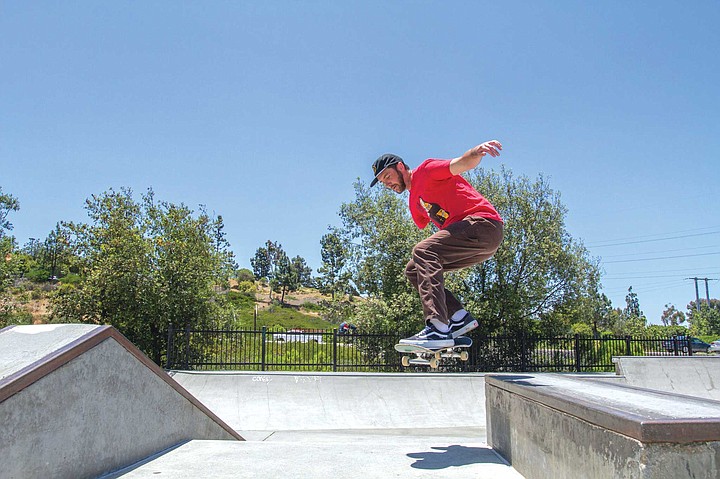
The thing about skateboarding merch is that it’s destined to be destroyed, which makes the newness on display here all the more glorious. Steel trucks gleam in glass cases beside bone-white wheels that still bear that tiny, ridged tread that wears away the instant they hit concrete. The center aisle is a long shirt rack: skate t-shirts on one side and punk bands on the other. There are vinyl records for sale beside assorted shoes and apparel, and of course, a massive wall of skate decks, overlapping like the scales of some giant, vibrant reptile.
Unique to the shop: an archive of Transworld mags, photo books, and of course, Kobriger’s art. Given all the portraits, the place feels almost like a gallery, so perhaps it’s not surprising to learn that Kobriger regularly pulls down his decks to open the walls for art shows. It’s remarkable how many veteran skaters have begun pursuing art as a career second act, and even more remarkable that Kobriger seems to know every one of them. In January, Steve Caballero held a show for his work in ink, applying his signature dragon graphic in a cartoonish style that honors the hot rod illustrations of Ed “Big Daddy” Roth. The line to meet him for autographs was so long it felt like 1985 all over again. Fellow Bones Brigader Lance Mountain’s ’80s graphics were more eclectic and primitive, but in the cartoon-forward 90’s, he introduced his yellow “doughboy,” and it’s been his go-to figure ever since. In February, he visited with drawings and skate photography from over the years, and paired the day with a pro session at PQ park hosted by the British skate company Flip. From a slightly later era, artist and skater Jason Adams made the trek down from the Bay Area for the shop’s grand opening in December, displaying stenciled portraits of punk rockers and other rebel musicians. Small surprise: Kobriger himself has ventured into charcoal and India ink to capture similar artists like Bowie, Hendrix and Keith Richards.
Kobriger knows most of these artists through Punk Rock and Paintbrushes, a collective of skaters and rockers who have added visual art to their repertoire. He also plans to host more artists at the shop: Christian Hosoi, Ray Barbee and Matt Hensley — names that will be familiar to skaters of a certain era. In this way, the shop has a spirit to that of Closer — the latest gear for the modern age, but with the knowledge and reverence for everything and everyone who made skateboarding what it is today. It’s that sense of culture, he says, that gives any skateshop its soul. “It’s more than where you just buy a skateboard. It’s where you tell stories and connect with people. A place to mentor the next generation and pass on what you know, what skateboarding has taught you. Skateshops are usually not the most lucrative of endeavors; I think most people are probably too smart to ever try and open one. But sometimes heart trumps brain. The community needed us and that was enough of a reason to do it.”
Heart of Peñasquitos
The serendipity of partnering on a shop in PQ is not lost on Blair and Fitz, who grew up skating the sidewalks all around Sixes and Sevens. This was before communities saw the value of public skateparks, when skaters were the scourge of shopping centers and school campuses — wherever they could find a deep curb-cut, a ledge of perfect height, or stairs that made a good enough gap. “PQ has a pretty rich skateboarding history,” says Blair. “There’s a few pros and industry folks who have come out of this area, and there’s famous spots you can see in a lot of videos. I remember Mt. Carmel High was the hot spot one summer until it became a bust.”
Brian Reschke can offer perspective from municipal side: the current president of the Rancho Peñasquitos Town Council was a kid himself back in the days Blair mentions, and he can speak to the impact the skatepark has had. “It’s the biggest vandalism deterrent we have,” he says. “Once it opened, almost all the vandalism to the shopping centers literally dropped overnight.” (It’s worth noting that this vandalism in question isn’t just graffiti; it’s also curbs, ledges and rails scuffed by grinds and slides, before skateparks supplied features specifically made for such things.) For his part, Kobriger has been working with Reschke to make sure skateboarding is supported alongside more mainstream recreation. Says Reschke, “We needed lights at six of our parks with basketball courts — timed lights that automatically go off at nine. Paul advocated the same thing for the skatepark, because in the winter there’s only two hours of daylight after school, which isn’t very functional for a community. If we’re going to light our parks, we need to include all the parks that need lights in the same budget request.”
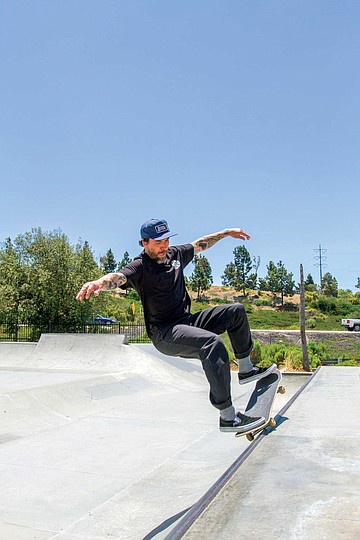
With support like that, those skaters throwing down tricks for cash on DATE may one day join the ranks of pros like Adrian Lopez from PQ, or Mira Mesa’s Willy Santos, who rode for Tony Hawk’s Birdhouse brand and had his own Peñasquitos skateshop in the ’00s. Or John Lupfer, another PQ native who is now a pro for the skate company Stereo. He drove down from LA for the event, to see his family and meet up with teammates Bryce Wettstein of Encinitas — a recent Olympian — and Chris “Dune” Pastras, a longtime icon who may be due for one of Kobriger’s portraits. “I got my start at a contest just like this,” Lupfer says, recalling the days when Willy’s Workshop would set up ramps in their parking lot. “I got sponsored by Willy’s, then Osiris Shoes, and they sent my tape to Stereo and everything got rolling from there.”
A similar shop team is likely in the cards for Sixes and Sevens; in his days at Sun Diego, Kobriger assembled and managed teams that ultimately launched the careers of Tyler Surrey, Marius Syvänen, Julian Davidson and Wes Kremer, the 2014 Thrasher Skater of the Year who Paul sponsored at just eleven years old. That’s all on the horizon, though. For now, he’s doing what he can to provide gear to the local rippers, along with the once-locals like Lupfer.
“Apparently, I was the first sale as soon as the online shop opened,” Lupfer says. “I saw that Sixes and Sevens board that said ‘Peñasquitos’ with the Padres colors, and yeah, I had to have one of those.”
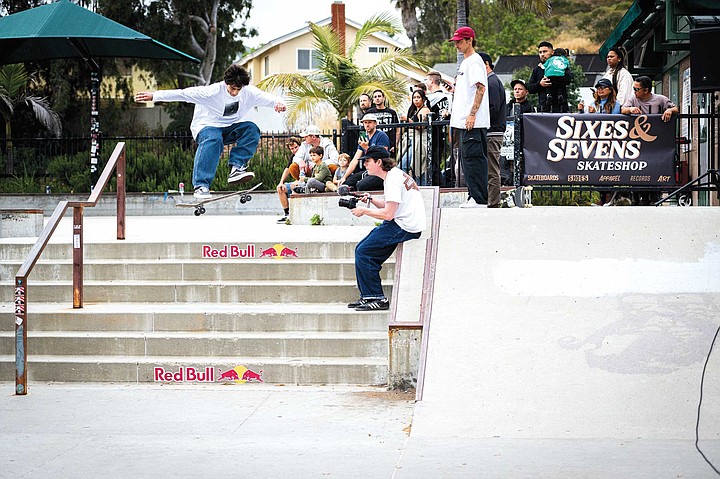
Bringing It Home
Back at the park, the prize cash was getting thin. For the grand finale down the double set of stairs, 28-year-old Brian Hastings from El Cajon nailed a switchstance 360° flip — called a “tre” nowadays — on his first try, to take home $300. After the session, the crowd ambled over to Sixes and Sevens for a photo show celebrating Closer’s one-year anniversary. The decks were down, replaced by prints that spanned decades and generations, just like the attendees. Photographer J. Grant Brittain was there, one of the founding staff at Transworld. Now 67, he relayed stories of his home skateshop and park back in the ’70s and ’80s: the Del Mar Skate Ranch. “The skateshop is the gathering place,” he said. “It’s the clubhouse, especially back when we all were misfits. This shop has more going on with the art and music, but the heart is the same.”
The daylight gave way to dark, which made the shop seem brighter inside, its lights falling on teenagers with boards in hand, parents with kids, old-timers — all brought together by a shared love of skateboarding.
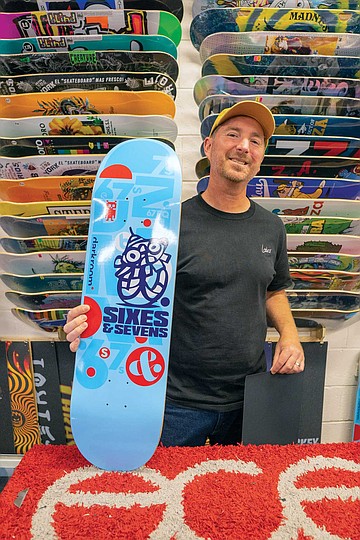
“So were you around in big pants, small wheels era?” someone asks. “Because a lot of old-schoolers dropped out around then.”
“Oh yeah, I was in for it all,” someone answers. “I was just like, ‘So we’re all doing this now? Ok cool, let’s go skate!’”
All around, people conversed about their memories of different decades, debated the pros and cons of everslick boards, compared injuries caused by the board to those of old age and those of jiu-jitsu. “
“PQ is sort of my home park,” said Kobriger. “I’ve been skating here for over a decade. All three of my kids learned to drop in there. So when the opportunity came to open up a shop, I knew we could do something special for the community. I wanted to give back, and now we’re doing all that we can.”
It reminded me of something he said at the skatepark; he was the one passing bills to the skaters who landed their tricks. The stack was getting low, and he wished he had more to go around. “I should have got more fives,” he said. I assumed he was just being hard on himself. But it was just the sentiment of someone who wants to do more with what he’s been given, to give what he can to what skateboarding is: a sport, a discipline, a community — one that he says has given him everything: heroes, friends, a career, and above all, life lessons. For one, skateboarding is a practice in humility. That board will throw you to the ground a lot more than you want — just like life. But that makes it an exercise in resilience as well. Because you have to get back up, and you have to keep trying. You do all you can.
Jarrett Haley is a writer and editor in San Diego. He is the copywriter for the agency Traina, and can be found at jarretthaley.com.


June 10th began gray and damp, the way it had been all spring. But by the afternoon, the concrete at the Rancho Peñasquitos skatepark was dry, the DJ was spinning, and you could hear the man on the mic urging the local skaters to land their tricks and “get some of this Red Bull money!” Sponsor happy talk like that might have tempted you to think that this was some corporate-backed festival, but the vibe in the park was more organic, more like a block party. The skaters who had come out would have come out on any other day, they just would have been more chill. As it was, they were taking rapid-fire runs at the same rail or gap, those who bailed had barely enough time to grab their boards before another body came barreling along. Each time one of them landed a trick, the crowd cheered, and the triumphant skater rolled past a guy who was waiting with bills in hand, snagged a twenty, and got back in the lineup to try something new.

While standing with the spectators I met Mike Fitzgerald, who grew up skating in Peñasquitos (or PQ) and now lives here with his wife and their two children. “There’s been more things happening at this skatepark in six months than there has been in 18 years,” he told me. “And that’s all because of the shop and Paul.” The shop is Sixes and Sevens, sitting one block away, and the Paul is Paul Kobriger, its founder. It’s equal parts skateshop, art gallery, record store, music venue — anything it needs to be, really. Fitzgerald (or “Fitz”) may be biased in his opinion of the place, as he’s one of the five friends who Kobriger brought in as partners. But he’s right on the facts: more events have happened here, and there really is something new going on, some energy being brought into an otherwise ordinary piece of suburbia. It’s amazing: that skaters young and old are coming to PQ to see their pro heroes, that those pros are coming here at all, that there’s a crowd of people hanging out outside an 800 square foot shop in a strip mall. All this points to something special going on inside.
It starts to make sense when you learn that Kobriger and most all his partners came from Transworld SKATEboarding magazine, or TWS, one of the biggest media titles in the skate industry. Despite that status, it shuttered its print publication in 2019, and left nearly all of Kobriger and his partners adrift, searching for something else into which they could pour their skate-loving hearts.
The Day It Went Down
One evening in late January of 2019, an impromptu staff meeting was called for the start of the next day — never a good sign. Transworld had about a dozen full-time employees, and that morning, they arrived expecting the worst. For Brian Blakely, the managing editor who’d just spent two months recovering from an ATV accident that took his right arm, it was his first day back in the office. After arriving, employees were split into two groups: one in the conference room, one in the mag’s skatepark. If you were in the park, you were getting let go, laid off, the ol’ pink slip — sometimes it seems there are as many euphemisms for losing a job as there are for dying. The axe didn’t fall all at once, but the pandemic was coming, and soon enough, the surviving camp dwindled as well. The downsizing was part of an acquisition, and though this wasn’t the first time the magazine had changed hands, this time was different —in part because it happened during its leanest times. Transworld and a handful of action sports brands under The Enthusiast Network was bought by American Media, Inc., of National Enquirer fame. The elimination of print is almost expected in the digital age, but the salt in the wound was that the remainder of subscriptions would be fulfilled with issues of that atlas of ripped abs, Men’s Journal.

Enough: there’s no need to dwell upon the decline of print media — especially not in the pages of one of the last free local weeklies in town (and if you’re reading this without battery power, bravo, you old soul). As much as it made old-school hearts ache, after 36 years it was time to bid farewell to what many would have called the most professional and most polished skate publication going. Thrasher has always worn its rawness with pride. To sum up, the loss of a printed Transworld SKATEboarding was indeed a loss. But this is not a story of decline; it’s the story of the rise that followed after. Because that’s the thing about print, right? You can’t move on unless you turn a page.
The Art of Reinvention
Paul Kobriger had been Transworld’s marketing director, the guy in charge of special events and promotion. With a family of five to support, he started doing some contract work with industry connections. But out of necessity, he also leaned hard into his art — a hobby he’d been working on for a few years before the TWS exodus. He hadn’t drawn a single line since high school, but over time, he’d been inspired by the side projects and hustles of his TWS colleagues. “They were all creatives in and outside of their day jobs,” he says. “Being around them every day inspired me to have some sort of creative outlet, too.” He took up a simple Bic pen and set to recreating a TWS cover that featured a monotone, high-contrast photo — well-suited for ink.
“I knew I didn’t want to do pencil like everyone else,” he says. “A lot of people don’t realize you can manipulate a ball-point just like a pencil, but you have to get the technique down —light strokes, layer by layer. It started out as a practice piece, but I just kept going with it. You can actually see it getting better from the left side to the right as I progressed through the drawing.” The result was enough to blow some minds when he showed it around the office. Fitz puts it best: “It was like knowing someone ten years and suddenly they sit at a piano and play Mozart. We were all like, ‘What?!’”
Paul moved on to large-scale, hyper-realistic portraits, starting by working (with permission) from photo portraits of his three longtime skate heroes: the perpetually comic Lance Mountain, the ever-cheerful Ray Barbee, and the consummately creative Mark Gonzales. “I discovered that if you’re trying to connect with people, portraits just work well. At least more so than drawing a skyline or street corner, or something like that. And especially with those three skaters — they were my favorite skaters growing up. Anyone that started skating around that era would probably tell you the same thing.”
While most anyone would be staggered by the detail in each, Paul can see his work progressing throughout the series, getting more and more photorealistic. “Lance is done in stipple; I didn’t have confidence in shading yet, because ball-points are finicky. You have to figure out how to manipulate them so a big black ink gob doesn’t suddenly bleed out. Obviously, you can’t erase.”
There’s a coffee mug on his desk that holds empty pens — empty as in bone-dry, with a crystal-clear barrel. An 18”x24” piece takes only one or two pens. Time is another matter. “Each is at least 150 hours, often more. I start with a pencil sketch and then use a grid system to ink it; one square inch takes about an hour with a pen, depending on the detail.” So it’s as much labor as it is love. When the magazine folded and he had mouths to feed, he thought how his Transworld colleagues had told him he could have a future in art. “I always told myself I wouldn’t sell the originals until I could get what I thought they were worth, based on the time that goes into them,” he says. “And yeah, soon after I offered the originals on Instagram, they all sold. Letting them go was a little bittersweet, but I was stoked that I had built a following and could sell them for what I held out for.”

All the while, Kobriger was skating at his go-to park in Peñasquitos. Over time, the thought started creeping up on him: here was a park that drew skaters from all over, near lots of family-friendly neighborhoods producing new skaters every year, and yet there was no dedicated skateshop nearby. Outside of the craziness of starting a business in general, the idea of filling that particular niche wasn’t all that crazy.
Paul had worked in or with skateshops for nearly his whole career, running marketing for Sun Diego Boardshops and CCS.com, the largest online skate retailer of its time. But to get his own shop going, he’d need partners. He knew who to ask — and for all five of them, it was an easy answer. “You can see it in his art,” says Fitz. “Anything he does, Paul goes all-in. He probably could have asked us to be a part of anything he was starting, and we’d have agreed in an instant.”
Fitz was the first ask; he knew PQ and could literally see the shop location from his house; Blair Alley also grew up in PQ and was still holding on at Transworld, running the entire show online, with Brian Blakely on contract for web stories. They were both in, as was Paul’s designer, Matt Kriegel, who would be cut in on whatever merch he designed for the shop. And though he rounds out this roundup of partners, former editor-in-chief Jaime Owens wasn’t the last to be asked and was definitely not the least. He’s just got a whole reinvention story of his own.
Long Live Print
For Owens, the end of the print mag was a rude awakening from a dream career he fell into 24 years prior. Fresh to SoCal from South Carolina, a then-25-year-old Owens sent an email to Skateboarder — the only magazine that printed staff emails — and was, to his surprise, taken right under the wing of photographer Mike Ballard, who needed help hauling equipment. This put him in the right place at the right time to get involved in the first season of a new MTV show, Jackass, before it became the sensational nut-punching media franchise. Connections ensued, and Jaime was offered a full-time gig at Skateboarder, working his way up over the years from essentially a paid intern to editor-in-chief. That mag folded in 2013, but he slid right into the same role at Transworld. “There’s always some degree of paranoia working in publications,” he says. “If you’re not wondering whether you’ll put out another issue next month, you’re wondering if the ad numbers are being hit, and it can be stressful.”
With more than 20 years in skate magazines, Jaime has seen the thick and thin times, which manifest themselves physically when you stack issues and look at the spines. In the early 00’s, Transworld was almost an inch thick and flush with advertisers; toward the end, it was a considerably trimmer issue, even though it was put out every other month. He’d been a part of all kinds of efforts to modernize over the years, like digital issues with still images that came to life as video that were the last gasp of Skateboarder. “The thought was everyone was going to have an iPad and that’s how content would be consumed. That didn’t really pan out, but we pioneered some really cool stuff.” Social media is what really turned the tide, which makes sense when you consider skateboarding’s history as captured by grassroots, guerilla-style coverage — it became what it is today only because skaters captured each other on film. Photographers like J. Grant Brittain, Glen E. Friedman and C. R. Stecyk III documented the early days like ethnographers, and skate mags were the culture’s National Geographic. When camcorders became widespread in the ‘90s, magazines started producing their own videos, which became requisite for any company in skateboarding, media or otherwise. But once everyone could reach everyone else instantly and globally via the device in their pocket, skaters became their own media outlets. That diluted the role of the magazine as the source for the latest and greatest, and accelerated the pace of content production well beyond what a perfect-bound monthly could match.

Though Owens was relieved to be without deadlines for the first time in two decades, TWS’s print death still left a void. He kept skateboarding every day, took freelance photo gigs and worked on one-off projects, but he couldn’t shake the longing for some way to share his true enthusiasm. “All I knew was making skate magazines and skate content. And that’s all I wanted to do, but in a way that was more feasible and more meaningful, too.” He envisioned another kind of magazine, one not focused on scooping the latest shots, but on speaking deeply and holistically to skateboarding’s entire story. A magazine as much about heritage as the latest hotness. “A magazine about the love of skateboarding,” he says, “not just crazy tricks, but stories and interviews and photos to make you really feel something — whether its nostalgia or just the stoke of a great photo.” The result was Closer, pronounced not like someone who seals deals, but like the proximity. He decided he’d resurrect the print format, but publish in a quarterly cadence and with a premium package: high-quality paper and thoughtful content. The magazine would be a collectible, something meant to live on the coffee table for a while. It’s a model The Surfer’s Journal has had for more than 30 years, and its publisher, Brendon Thomas, even showed Owens the ropes. Now, Closer is one year and four issues in, and it’s going well enough that Brian Blakely has joined him as copyeditor.
“We’ve known each other since Skateboarder,” says Blakely. “Closer is really a reflection of Jaime and how deep he goes into everything as a straight-up skater. It’s nice not to have the corporate side of things getting in the way of that.”
“It’s a more sustainable model across the board,” Owens says. “A limited, quality product for a specific audience. The idea is not to take over the world, just bring together like-minded people who are down to support what you’re doing. You’re not trying to get ‘subscribers’ so much as building up members of a community.”
Starting the shop
Kobriger dubbed his new venture Sixes and Sevens after an old English phrase denoting confusion and disarray — exactly the circumstances that birthed the place. He was putting it in order, though, fixing up his spot just 10 pushes of a skateboard away from PQ park — three if you were going downhill. Skateshops are common in densely populated areas along the coast, but PQ was near freeways and about midway between Downtown San Diego and North County proper. Kobriger had plans to make a drive worth it. “Skateshops can be an intimidating place,” he recalls, “but I wanted Sixes and Sevens to be really inclusive and give off a positive vibe where people would leave with a good feeling. Talking to people is one of the best parts of the job. If someone walks in these doors, it’s because they have an interest in skateboarding, music, or art. I love those conversations, whether with kids or parents or anyone in between.”

The thing about skateboarding merch is that it’s destined to be destroyed, which makes the newness on display here all the more glorious. Steel trucks gleam in glass cases beside bone-white wheels that still bear that tiny, ridged tread that wears away the instant they hit concrete. The center aisle is a long shirt rack: skate t-shirts on one side and punk bands on the other. There are vinyl records for sale beside assorted shoes and apparel, and of course, a massive wall of skate decks, overlapping like the scales of some giant, vibrant reptile.
Unique to the shop: an archive of Transworld mags, photo books, and of course, Kobriger’s art. Given all the portraits, the place feels almost like a gallery, so perhaps it’s not surprising to learn that Kobriger regularly pulls down his decks to open the walls for art shows. It’s remarkable how many veteran skaters have begun pursuing art as a career second act, and even more remarkable that Kobriger seems to know every one of them. In January, Steve Caballero held a show for his work in ink, applying his signature dragon graphic in a cartoonish style that honors the hot rod illustrations of Ed “Big Daddy” Roth. The line to meet him for autographs was so long it felt like 1985 all over again. Fellow Bones Brigader Lance Mountain’s ’80s graphics were more eclectic and primitive, but in the cartoon-forward 90’s, he introduced his yellow “doughboy,” and it’s been his go-to figure ever since. In February, he visited with drawings and skate photography from over the years, and paired the day with a pro session at PQ park hosted by the British skate company Flip. From a slightly later era, artist and skater Jason Adams made the trek down from the Bay Area for the shop’s grand opening in December, displaying stenciled portraits of punk rockers and other rebel musicians. Small surprise: Kobriger himself has ventured into charcoal and India ink to capture similar artists like Bowie, Hendrix and Keith Richards.
Kobriger knows most of these artists through Punk Rock and Paintbrushes, a collective of skaters and rockers who have added visual art to their repertoire. He also plans to host more artists at the shop: Christian Hosoi, Ray Barbee and Matt Hensley — names that will be familiar to skaters of a certain era. In this way, the shop has a spirit to that of Closer — the latest gear for the modern age, but with the knowledge and reverence for everything and everyone who made skateboarding what it is today. It’s that sense of culture, he says, that gives any skateshop its soul. “It’s more than where you just buy a skateboard. It’s where you tell stories and connect with people. A place to mentor the next generation and pass on what you know, what skateboarding has taught you. Skateshops are usually not the most lucrative of endeavors; I think most people are probably too smart to ever try and open one. But sometimes heart trumps brain. The community needed us and that was enough of a reason to do it.”
Heart of Peñasquitos
The serendipity of partnering on a shop in PQ is not lost on Blair and Fitz, who grew up skating the sidewalks all around Sixes and Sevens. This was before communities saw the value of public skateparks, when skaters were the scourge of shopping centers and school campuses — wherever they could find a deep curb-cut, a ledge of perfect height, or stairs that made a good enough gap. “PQ has a pretty rich skateboarding history,” says Blair. “There’s a few pros and industry folks who have come out of this area, and there’s famous spots you can see in a lot of videos. I remember Mt. Carmel High was the hot spot one summer until it became a bust.”
Brian Reschke can offer perspective from municipal side: the current president of the Rancho Peñasquitos Town Council was a kid himself back in the days Blair mentions, and he can speak to the impact the skatepark has had. “It’s the biggest vandalism deterrent we have,” he says. “Once it opened, almost all the vandalism to the shopping centers literally dropped overnight.” (It’s worth noting that this vandalism in question isn’t just graffiti; it’s also curbs, ledges and rails scuffed by grinds and slides, before skateparks supplied features specifically made for such things.) For his part, Kobriger has been working with Reschke to make sure skateboarding is supported alongside more mainstream recreation. Says Reschke, “We needed lights at six of our parks with basketball courts — timed lights that automatically go off at nine. Paul advocated the same thing for the skatepark, because in the winter there’s only two hours of daylight after school, which isn’t very functional for a community. If we’re going to light our parks, we need to include all the parks that need lights in the same budget request.”

With support like that, those skaters throwing down tricks for cash on DATE may one day join the ranks of pros like Adrian Lopez from PQ, or Mira Mesa’s Willy Santos, who rode for Tony Hawk’s Birdhouse brand and had his own Peñasquitos skateshop in the ’00s. Or John Lupfer, another PQ native who is now a pro for the skate company Stereo. He drove down from LA for the event, to see his family and meet up with teammates Bryce Wettstein of Encinitas — a recent Olympian — and Chris “Dune” Pastras, a longtime icon who may be due for one of Kobriger’s portraits. “I got my start at a contest just like this,” Lupfer says, recalling the days when Willy’s Workshop would set up ramps in their parking lot. “I got sponsored by Willy’s, then Osiris Shoes, and they sent my tape to Stereo and everything got rolling from there.”
A similar shop team is likely in the cards for Sixes and Sevens; in his days at Sun Diego, Kobriger assembled and managed teams that ultimately launched the careers of Tyler Surrey, Marius Syvänen, Julian Davidson and Wes Kremer, the 2014 Thrasher Skater of the Year who Paul sponsored at just eleven years old. That’s all on the horizon, though. For now, he’s doing what he can to provide gear to the local rippers, along with the once-locals like Lupfer.
“Apparently, I was the first sale as soon as the online shop opened,” Lupfer says. “I saw that Sixes and Sevens board that said ‘Peñasquitos’ with the Padres colors, and yeah, I had to have one of those.”

Bringing It Home
Back at the park, the prize cash was getting thin. For the grand finale down the double set of stairs, 28-year-old Brian Hastings from El Cajon nailed a switchstance 360° flip — called a “tre” nowadays — on his first try, to take home $300. After the session, the crowd ambled over to Sixes and Sevens for a photo show celebrating Closer’s one-year anniversary. The decks were down, replaced by prints that spanned decades and generations, just like the attendees. Photographer J. Grant Brittain was there, one of the founding staff at Transworld. Now 67, he relayed stories of his home skateshop and park back in the ’70s and ’80s: the Del Mar Skate Ranch. “The skateshop is the gathering place,” he said. “It’s the clubhouse, especially back when we all were misfits. This shop has more going on with the art and music, but the heart is the same.”
The daylight gave way to dark, which made the shop seem brighter inside, its lights falling on teenagers with boards in hand, parents with kids, old-timers — all brought together by a shared love of skateboarding.

“So were you around in big pants, small wheels era?” someone asks. “Because a lot of old-schoolers dropped out around then.”
“Oh yeah, I was in for it all,” someone answers. “I was just like, ‘So we’re all doing this now? Ok cool, let’s go skate!’”
All around, people conversed about their memories of different decades, debated the pros and cons of everslick boards, compared injuries caused by the board to those of old age and those of jiu-jitsu. “
“PQ is sort of my home park,” said Kobriger. “I’ve been skating here for over a decade. All three of my kids learned to drop in there. So when the opportunity came to open up a shop, I knew we could do something special for the community. I wanted to give back, and now we’re doing all that we can.”
It reminded me of something he said at the skatepark; he was the one passing bills to the skaters who landed their tricks. The stack was getting low, and he wished he had more to go around. “I should have got more fives,” he said. I assumed he was just being hard on himself. But it was just the sentiment of someone who wants to do more with what he’s been given, to give what he can to what skateboarding is: a sport, a discipline, a community — one that he says has given him everything: heroes, friends, a career, and above all, life lessons. For one, skateboarding is a practice in humility. That board will throw you to the ground a lot more than you want — just like life. But that makes it an exercise in resilience as well. Because you have to get back up, and you have to keep trying. You do all you can.
Jarrett Haley is a writer and editor in San Diego. He is the copywriter for the agency Traina, and can be found at jarretthaley.com.
Comments